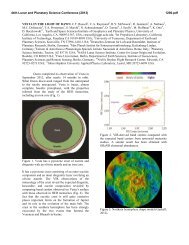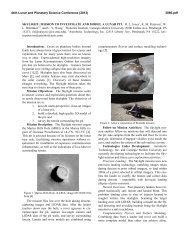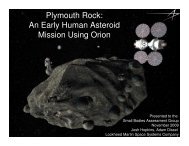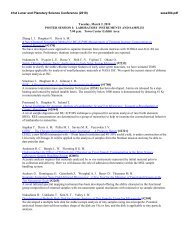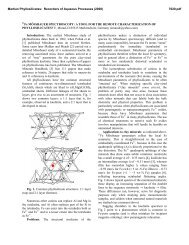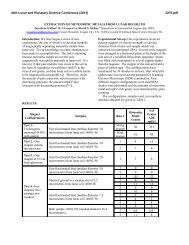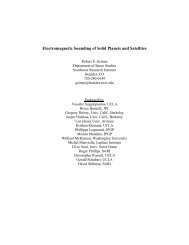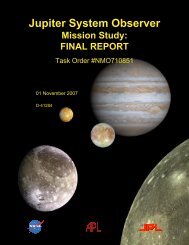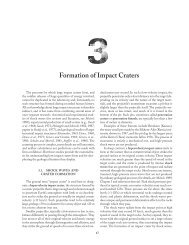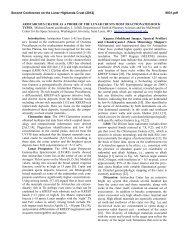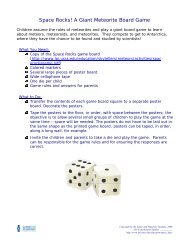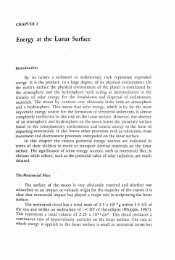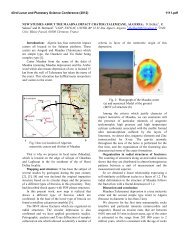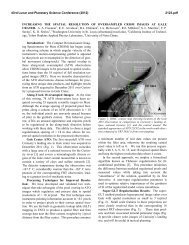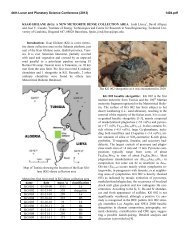Mars Entry, Descent, and Landing (EDL): Considerations for
Mars Entry, Descent, and Landing (EDL): Considerations for
Mars Entry, Descent, and Landing (EDL): Considerations for
Create successful ePaper yourself
Turn your PDF publications into a flip-book with our unique Google optimized e-Paper software.
Concepts <strong>and</strong> Approaches <strong>for</strong> <strong>Mars</strong> Exploration (2012)<br />
<strong>Mars</strong> <strong>Entry</strong>, <strong>Descent</strong>, <strong>and</strong> L<strong>and</strong>ing (<strong>EDL</strong>): <strong>Considerations</strong> <strong>for</strong> Crewed L<strong>and</strong>ing. R. R. Sostaric 1 , C. C. Campbell<br />
2 ; 1 NASA Johnson Space Center, Mailcode: EG5, 2101 NASA Parkway, Houston, TX 77058, ronald.r.sostaric@nasa.gov,<br />
2 NASA Johnson Space Center, Mailcode: EG3, 2101 NASA Parkway, Houston, TX<br />
77058, charles.c.campbell@nasa.gov.<br />
Introduction: Human missions to <strong>Mars</strong> require<br />
l<strong>and</strong>ing multiple spacecraft carrying usable payload<br />
masses on the order of 20-40 metric tons (MT). 1 Previous<br />
studies have shown that in order to l<strong>and</strong> 40 MT<br />
of payload, masses of 80-110 MT are required in <strong>Mars</strong><br />
orbit prior to <strong>Entry</strong>, <strong>Descent</strong>, <strong>and</strong> L<strong>and</strong>ing (<strong>EDL</strong>). 2<br />
Precision l<strong>and</strong>ing is critical, as multiple mission elements<br />
will be required <strong>for</strong> mission success. The thin<br />
Martian atmosphere creates additional challenges, requiring<br />
a large drag area during entry. Additionally,<br />
aerocapture has been shown to be of mass benefit over<br />
chemical propulsive capture. This requires thermal<br />
protection which is capable of enduring two large heat<br />
pulses (aerocapture <strong>and</strong> entry) which may have a long<br />
time interval in between (possibly on the order of<br />
months in the event of dust storms).<br />
Human <strong>EDL</strong> on <strong>Mars</strong> has additional challenges<br />
which may be unique or of lower priority <strong>for</strong> <strong>Mars</strong> robotic<br />
l<strong>and</strong>ings. These constraints, in addition to those<br />
above, will likely drive the choice of <strong>EDL</strong> architecture<br />
<strong>for</strong> human missions. The constraints include transition<br />
from entry to descent <strong>and</strong> l<strong>and</strong>ing, load magnitude <strong>and</strong><br />
direction, reliability, timing of large attitude maneuvers<br />
(such as bank reversals or pitch-up during descent),<br />
<strong>and</strong> hazard detection <strong>and</strong> avoidance (HDA) related<br />
maneuvering.<br />
<strong>Considerations</strong> <strong>for</strong> Human <strong>Mars</strong> <strong>EDL</strong>: The following<br />
discusses some of these considerations <strong>for</strong> human<br />
<strong>Mars</strong> <strong>EDL</strong> architecture design that may be considered<br />
unique from robotic missions.<br />
Loads. Mission concepts show that the crew will be<br />
significantly de-conditioned due to being in zero-G<br />
during a six month Earth-to-<strong>Mars</strong> transfer. 1 Total Glimits<br />
under the “Limit <strong>for</strong> Return to Earth” heading is<br />
4 G’s in the “eyeballs in” <strong>and</strong> “eyeballs out” directions<br />
<strong>for</strong> extended periods (about 100 sec <strong>and</strong> longer). 3<br />
Though the exact crew loads limit criteria is not defined<br />
<strong>for</strong> <strong>Mars</strong> <strong>EDL</strong> this is a reasonable place holder<br />
due to similar length ISS missions <strong>and</strong> subsequent crew<br />
return. Short durations allow <strong>for</strong> exceedance of the<br />
sustained 4 G limit. In other axes, the sustained crewed<br />
load limit is much more restrictive—1 G in the “eyeballs<br />
down” <strong>and</strong> side directions, <strong>and</strong> 0.5 G in the “eyeballs<br />
up” direction.<br />
Significant loading during <strong>EDL</strong> is encountered both<br />
during entry <strong>and</strong> powered descent. The preferred orientation<br />
is through the chest. However, depending on the<br />
orientation of the crew in the entry vehicle <strong>and</strong> the<br />
thrust axis of the descent stage, it may be required to<br />
re-orient the crew during the transition from entry to<br />
powered descent in order to meet load constraints. If<br />
required, a re-orientation would be a significant design<br />
driver <strong>for</strong> the internal volume of the vehicle. An additional<br />
consideration is crew disorientation that may<br />
occur as a result of the vehicle transition to the l<strong>and</strong>ing<br />
configuration. Since this re-orientation occurs prior to<br />
or at the start of powered descent, significant attention<br />
to the design will be necessary to avoid excessive disorientation<br />
right be<strong>for</strong>e this critical phase of flight.<br />
Transition. Current concepts show that separating a<br />
large (~50 MT) descent system from an 10 m x 30 m<br />
rigid aeroshell, or 23 m hypersonic inflatable aerodynamic<br />
decelerator (HIAD) at supersonic conditions is<br />
required. 2 This critical flight phase occurs at an altitude<br />
of a few kilometers (km). Transition concepts are not<br />
sufficiently mature <strong>and</strong> work is being undertaken to<br />
develop them in greater detail. What is clear is that the<br />
transition design may, or is even likely to, drive the<br />
choice of <strong>EDL</strong> architecture.<br />
Reliability. Reliability <strong>and</strong> safety <strong>for</strong> human missions<br />
can drive architecture selection <strong>and</strong> have a large<br />
impact on total implementation costs. Complex capabilities<br />
with multi-faceted failure modes or systems<br />
needing lengthy <strong>and</strong> costly flight test programs to demonstrate<br />
failure mode robustness <strong>and</strong> design qualification<br />
should be less favored in ef<strong>for</strong>ts advertising an<br />
ultimate human mission. Emphasis on system complexity<br />
characterization <strong>and</strong> <strong>for</strong>ward-leaning planning <strong>for</strong><br />
reliability evaluation should be included as part of<br />
technology developments ef<strong>for</strong>ts. Areas of particular<br />
focus along these lines could include vehicle transitions,<br />
as mentioned earlier, as well as identification of<br />
full scale entry vehicle systems that are unlikely to be<br />
sufficiently qualified <strong>and</strong> certified in ground based<br />
testing. Failing to address this question adequately can<br />
lead to a mature design <strong>for</strong> non-human systems that is<br />
untenable <strong>for</strong> human missions due to implementation<br />
cost <strong>and</strong> schedule requirements <strong>for</strong> a human system.<br />
Precision L<strong>and</strong>ing. Mission scenarios show that a<br />
cargo mission will be placed on the surface prior to the<br />
crewed l<strong>and</strong>ing. Precision l<strong>and</strong>ing is an important consideration<br />
<strong>for</strong> any multiple asset mission design. The<br />
crew will have to be able to l<strong>and</strong> near the pre-placed<br />
asset(s), so mobility capability must be equal to or<br />
greater than the expected l<strong>and</strong>ing precision. Active<br />
entry guidance with sufficient trajectory control capability<br />
will be necessary to reduce propellant usage during<br />
terminal descent to achieve the precise l<strong>and</strong>ings.<br />
4347.pdf
Concepts <strong>and</strong> Approaches <strong>for</strong> <strong>Mars</strong> Exploration (2012)<br />
Local precision is needed as well to avoid hitting the<br />
pre-placed assets as well as any natural hazards such as<br />
rocks, slopes, or craters. Approach trajectories must be<br />
designed to minimize risk to pre-placed assets or crews<br />
in the event of failure during <strong>EDL</strong>. The predicted impact<br />
location of any aeroshell or stage intended to be<br />
jettisoned must also be well away from ground assets.<br />
The Autonomous L<strong>and</strong>ing <strong>and</strong> Hazard Avoidance<br />
Technology Project (ALHAT) is developing a suite of<br />
sensors <strong>and</strong> algorithms, along with integrated GN&C<br />
<strong>and</strong> avionics, to per<strong>for</strong>m the precision l<strong>and</strong>ing <strong>and</strong> the<br />
hazard detection <strong>and</strong> avoidance function. 6<br />
Powered <strong>Descent</strong>. Previous studies have shown that<br />
supersonic engine start-up will be required to support<br />
supersonic retropropulsion. 2 Maximum descent loads<br />
may be as high as 3 G’s. Apollo lunar l<strong>and</strong>ings utilized<br />
a significantly different descent <strong>and</strong> l<strong>and</strong>ing approach<br />
than expected <strong>for</strong> <strong>Mars</strong> l<strong>and</strong>ing. The timeline <strong>for</strong> <strong>Mars</strong><br />
is very compressed, as shown in Fig 1. 245<br />
In Apollo, the high gate marked a switch in guidance<br />
mode to account <strong>for</strong> the crew actively receiving<br />
visual in<strong>for</strong>mation about the l<strong>and</strong>ing area <strong>and</strong> making<br />
frequent adjustments to the l<strong>and</strong>ing target. This phase<br />
began with about 205 sec remaining to touchdown.<br />
<strong>Mars</strong> simulation results show powered descent beginning<br />
with only about 60 sec to touchdown remaining, at<br />
a supersonic flow condition. The compressed timeline<br />
means that critical events <strong>and</strong> decisions will have to be<br />
made more quickly, <strong>and</strong> high quality in<strong>for</strong>mation about<br />
the l<strong>and</strong>ing area will be even more critical.<br />
Figure 1. <strong>Descent</strong> Trajectory Comparison<br />
Hazard Detection <strong>and</strong> Avoidance. The hazard detection<br />
function can be partially or totally completed<br />
prior to the mission, via remote sensing, l<strong>and</strong>ing site<br />
selection, or l<strong>and</strong>ing area modification. Real time hazard<br />
detection may be needed <strong>for</strong> additional risk mitigation.<br />
During Apollo, crew members per<strong>for</strong>med the<br />
real-time hazard detection function by looking out a<br />
window with a down range view of the l<strong>and</strong>ing area.<br />
The ALHAT project has developed a flash lidar suita-<br />
ble <strong>for</strong> mapping 3-D hazard fields <strong>for</strong> real-time hazard<br />
detection. The flash lidar is designed to be capable of<br />
detecting 30 cm hazards at a distance of 1 km. 6<br />
Hazard avoidance requires a redesignation decision<br />
with enough time, altitude, <strong>and</strong> propellant <strong>for</strong> a divert<br />
maneuver, as well as adequate knowledge of the l<strong>and</strong>ing<br />
area. The redesignation location is limited to the<br />
size of the l<strong>and</strong>ing area, which is defined as the area<br />
about which adequate hazard in<strong>for</strong>mation is known.<br />
Figure 2 depicts the hazard avoidance strategy. Enough<br />
divert capability must be budgeted to respond to updated<br />
hazard in<strong>for</strong>mation when it is expected to become<br />
available. As the vehicle approaches the l<strong>and</strong>ing<br />
site, at some point it will no longer have enough divert<br />
capability to reach all points in the divert area. The<br />
divert capability will continue to decrease as the vehicle<br />
gets closer to l<strong>and</strong>ing. A final, constant vertical<br />
velocity phase with minimal or zero horizontal velocity<br />
is employed just prior to touchdown.<br />
Figure 2. Hazard Avoidance Strategy<br />
Summary: Human missions to <strong>Mars</strong> will require<br />
<strong>EDL</strong> technologies <strong>and</strong> capabilities beyond those required<br />
<strong>for</strong> heavy robotic missions. Developing <strong>and</strong><br />
testing these new approaches while pursuing robotic<br />
missions will prevent future delays <strong>and</strong> inadequacies<br />
when eventual human <strong>Mars</strong> designs become reality.<br />
References: [1] Human Exploration of <strong>Mars</strong> Design<br />
Reference Architecture 5.0, NASA-SP-2009-566<br />
(2009). [2] <strong>Entry</strong>, <strong>Descent</strong>, <strong>and</strong> L<strong>and</strong>ing Systems Analysis<br />
Study: Phase 1 Report, NASA/TM-2010-216720<br />
(2010). [3] Constellation Program Human-Systems<br />
Integration Requirements, CxP 70024, Baseline<br />
(2006). [4] Bennett, F.V. (1970) Lunar <strong>Descent</strong> <strong>and</strong><br />
Ascent Trajectories, MSC Internal Note No 70-FM-80.<br />
[5] Apollo 12 Mission Report, MSC-01855 (1970). [6]<br />
Epp, C.D., Robertson, E.A., Brady, T., Autonomous<br />
L<strong>and</strong>ing <strong>and</strong> Hazard Avoidance Technology<br />
(ALHAT), IEEE (2008). [7] Braun, R.D., Manning,<br />
R.M., <strong>Mars</strong> Exploration <strong>Entry</strong>, <strong>Descent</strong>, <strong>and</strong> L<strong>and</strong>ing<br />
Challenges, AIAA (2006).<br />
4347.pdf



